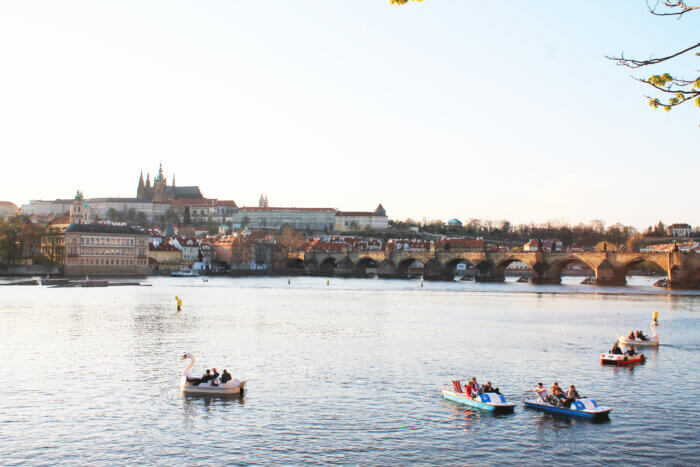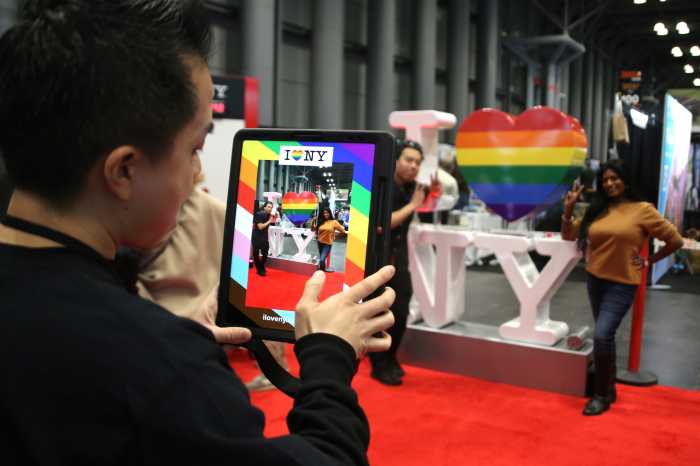There are many reasons to visit Prague, from its history to the vibrant LGBTQ community. Prague, the Czechian capital, has polished up in recent years after the fall of communism and the Iron Curtain in the early 1990s. But don’t take that as the city’s abandonment of its grittiness, quirkiness, and creativity.
As the city steps up its game by welcoming luxury hotels, re-envisioned traditional cuisine, and diverse culinary experiences, the country hasn’t completely embraced its entrance into the modern world. Czechia prefers its own currency, public art fills the city, underground nightclubs are thriving, and its LGBTQ community is still pushing for marriage equality and transgender rights, despite joining the European Union in 2004.
That’s partially what makes “The Golden City” so appealing to LGBTQ travelers, not to mention its fairytale architecture and its unique sense of style. Prague has so much of what queer travelers want, especially plenty of ways to connect with the local queer community.
What to do
Planning a gay trip to Czechia’s capital, Prague Saints, is an all-in-one gay stop. The travel agency offers LGBTQ accommodations, tours, and entertainment at its bar. Founded by gay expats from England, Portugal, Slovakia, and a Czech native in 2005, they are well immersed in The Golden City’s queer scene.
Walking tours are a great way to get to know a city and connect with locals. During my trip to Prague, I met up with Petr Prokopik, owner and tour guide of Prague4Gay.
Prokopik has hosted tours of his hometown since 1995. The leather-clad guide has a doctorate in anthropology and has taught gender studies. He is filled with interesting stories about the Czechian capital, including the evolution of Czechia and Prague into Czechian identity, the post-World War II rebranding, the Velvet Divorce in 1993, and the emergence of the modern era.
Today, “we are now almost uniquely culturally united,” Prokopik told me as we walked through the Old Town.
Part of that is reclaiming the country’s name. Commonly known as the Czech Republic, the Eastern European country changed its name to its historic name, Czechia, in 2016.
Czechia also lost nearly all of its Jewish and German communities after WW II, Prokopik said. Wittmann Tours was launched by Sylvie Wittmann, a queer woman, in 1990 after the fall of communism. Wittmann’s tours focus on Prague’s Jewish history and sites, in Prague’s Jewish neighborhood and at the Czechia concentration camp, Terezín.
A unique city
Prague is home to one of the largest collections of Cubist architecture, a short-lived trend. The city has more than 10 buildings featuring the structures built out of cubes, The House of the Black Madonna is the city’s crown jewel in the art form in the heart of Old Town Prague. The Black Madonna features a museum and café that serves breakfast and lunch.
Cubist architecture is only one of Prague’s unique structures. The city features Baroque, Gothic, Renaissance, Rococo, and Romanesque architecture that was left relatively untouched during the world wars of the 20th century and movements to demolish and build new buildings. Prague Castle, the Baroque castle perched above the city, and the Vltava River running through the ornate buildings give Prague its reputation of being a city frozen in a Grimm’s Brother fairytale.

The city’s centerpiece, the famed 15th-century stone arch bridge, the Charles Bridge, stretches across the Vltava River connecting Old Town with Lesser Town, attracting millions of visitors year after year.
However, the modern world also makes its impression throughout the city with its public art, much of it funded through the “Art for the City” project. The project purchases artists’ works, many sculptures, for public display, such as Czech sculptor David Černý’s works. Černý’s sculptures can be seen all over the city. Currently, there are nearly 600 total works of art around Prague.
The city also shows its quirky side with the narrowest street in Prague, Vinárna Čertovka. The “street” is 28 inches long and 20 inches wide. There is also The Petrin Tower, the 19th-century replica of the Eiffel Tower, which stands at the same altitude as Paris’s Iron Lady.
Gay life
Prague has a vibrant LGBTQ community centered around its “gay street,” Vinohradská Avenue, where many LGBTQ-owned businesses cater to the city’s queer life since the Velvet Revolution.
Prague Pride, which attracts thousands of revelers to the city, will celebrate its 13th annual festival August 7-13.
Nightlife
Gay travelers will find more than 20 gay bars, nightclubs, bathhouses, and gyms in Prague.
Prague’s newest LGBTQ nightclub is IP Club Prague. Opened in 2021, the club features DJ nights, drag shows, and Karaoke nights. It stays open until 5 a.m.
Gays can also be found at popular spots Q Café, TerMAX nightclub, houseboat bar and club U Bukanyra, and theater bar Svandovo divadlo.
Visit Prague’s oldest gay bars, Club U Rudolfa Prague, which has been a mainstay in “The Golden City” for possibly more than 40 years, and Piano Bar, which has entertained Prague’s LGBTQ community with drinks and regular drag shows for 25 years.
Queer women travelers find each other at night at lesbian-owned bar Destiny (formerly Jampa Dampa), or the monthly Freedom Night, a monthly queer women’s party produced by DJ Henriette, often hosted at the LGBTQ-friendly P.M. Club.
Other places queer women frequent are Saints Bar, Q Café, and TerMIX.
Queer women seeking non-bar and nightclub activities to get to know Prague’s queer women’s community, check out Rozdilne Rytmy, for organized outings from lectures to sports.
Where to eat
Prague has a culinary scene that is increasingly becoming diverse, offering authentic Mexican and Asian as well as plant-based cuisine, but for now, the city is still dominated by traditional Czechian gastronomy, which is close to Austrian and German dishes.
Prague’s celebrity chef Jiri Visek’s restaurant, Next Door, serves delicious Czechian cuisine with a modern take. Café-Café, an LGBTQ-welcoming spot, also serves traditional Czechian food for breakfast and lunch near the center of Prague. Celebrity Café offers breakfast and lunch and a nice wine and cocktail list, and Café Nona, a coffee spot, are also popular queer hangouts.
Good food can also be found at Atelier Petrin, which features dining on a terrace, and Buddha Bar, which serves up food with a soundtrack as the DJ spins the sounds. Prague is also developing a plant-based food scene with eateries such as Café Moment and Lehka Hlava Restaurant.
Where to stay
The Cosmopolitan Hotel offers a luxurious stay and is home to Next Door in the heart of Old Town Prague. The Andaz Prague opened in 2022 and is a sponsor of Prague Pride. The 5-star Hyatt boutique-style hotel is in Senovážné Square, close to the city’s Old Town.
Getting there and around
Tickets for a summer getaway to Prague are still low for August. Cut prices further by booking one-way tickets directly to Prague or make the journey a three-city adventure by train from Munich, Germany to Vienna, Austria to Prague.
































